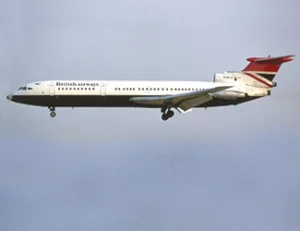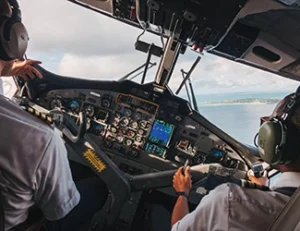Crew resource management
Training, research, and experience make flight operations safer.
By Don Witt
Contributing writer

In 1943, Boeing B-17 Flying Fortress crews in the UK thought of the number of missions that they had to fly before going home. With the horrendous loses occurring on each mission, they did not need paper and pencil to calculate their odds of surviving the war. They were very close to zero. If a captain somehow brought his crew through to the end of their tour of duty mostly intact, could one blame him for feeling he was somehow special?
After the war, this contributed to the development of a god complex for some airline captains. Failure of such individuals to heed advice or listen to any plan but their own led to several serious fatal accidents during the decades after the war.
In 1972, British European Airways Flight 548 – a Hawker Siddeley Trident – crashed near Staines-upon-Thames, killing all 118 aboard. The aircraft had 2 flight data recorders, but no cockpit voice recorder. Accident investigators concluded that the captain had retracted the leading edge devices at too low a speed, someone had disabled the shaker and pusher when they occurred, and the airplane entered an unrecoverable deep stall. This tragedy, known as the Staines Air Disaster, led the UK to require cockpit voice recorders by 1973, and to the development of formalized crew resource management (CRM) training.
In 1977, the infamous TFN (Tenerife North, Spain) runway collision occurred in the confusion of multiple diversions to the island airport in terrible visibility. It involved one of the most blatant examples of failure of CRM in aviation history, when the captain of KLM Flight 4805 dismissed the voice of his flight engineer, who warned him twice about Pan Am Flight 1736 still being on the runway.
As yet, there was no formal requirement for CRM training in the US, nor did it begin with this event.
In 1978, United Airlines Flight 173 experienced an anomaly when the pilots extended the landing gear for their approach to PDX (Intl, Portland OR). The crew became distracted in trying to analyze the problem, flying around PDX for nearly an hour, and finally lost all 4 of the Douglas DC-8’s engines to fuel starvation. Ten passengers and 2 crew members died in the subsequent off-airport crash landing. Richard Ferris, then United CEO, complemented the captain on his emergency landing with minimal loss of life. Later on, when the cause of the accident became clear, such accolades were retracted. The captain had ignored several suggestions from his crew that the fuel situation was becoming critical.
Advent of CRM

Aviation Psychologist Alan Diehl was a member of the NTSB investigative team for this accident. He referred to principles of CRM in the NTSB report. Shortly thereafter, NASA held an industry conference to discuss CRM.
In 1981, United Airlines rolled out the very first US CRM training program at its Denver CO training center. All pilots had to attend what was nearly a full week of initial CRM – then called command, leadership, and resource management (CLR).
It consisted of some lecture, but it was mostly exercises wherein individual pilots roll-played various cockpit seats in imaginary cockpits, where they were faced with various difficulties. We all got the message about cooperation and about 2 or 3 heads being better than one.
Over time, this training – and the recurrent CRM training that would follow – had a strong effect on United’s cockpits, although it could not turn every single pilot into an Al Haynes.
In 1989, United Airlines Flight 232 Captain Al Haynes and his crew gave a perfect demonstration of CRM in the most dire of circumstances. The center engine of their McDonnell Douglas DC-10 failed catastrophically, taking out all 3 hydraulic systems of the aircraft, leaving it with no operating flight controls whatsoever.
In the face of almost certain disaster, the crew calmly employed all the principles of CRM. Captain Haynes solicited input from his copilot and flight engineer at every point, and even invited a pilot traveling in the jump seat up to the cockpit. That man’s name was Dennis Fitch, and he was instrumental in controlling the aircraft using differential power of the wing-mounted engines. The prime lesson of CRM here is to invite and welcome input from every source available.
When Flight 232 contacted United’s engineering department by radio to learn what procedures existed for their situation, the company told them there were absolutely none. Failure of all 3 hydraulic systems was considered so unlikely that no procedures for this situation had ever been formulated.
By the 1990s, CRM principles were well understood and accepted in the western world. In fact, some United Airlines captains had begun complaining that first officers (FOs) were often advocating their positions too strongly and needed to back off. In these cases, the worm had certainly turned.
Enhancing CRM
As decades passed, the advocacy and cooperation that CRM preached became part of the culture with flightcrews. More and more, CRM training became folded into all aspects of initial and recurrent training. And when the subject became routine and boring, management introduced new concepts, like threat and error management (TEM).
CRM training now harbors more than its share of acronyms. At United Airlines, “CUS words” were introduced. The acronym stands for Concerned, Uncomfortable, and Safety of flight. They are used by an FO or a flight attendant. For example an FO could say to the captain, “I am feeling uncomfortable with this approach.” These words focus on the FO and his emotional state rather than the captain’s errors.
Now the captain could go around and try the approach again, believing that he is merely comforting his less experienced FO. Had the FO said something like “Your approach is unstable, you should go around,” the captain could have felt attacked and reacted negatively, continuing the dangerous approach.
TEM is a concept now presented in consort with CRM. Whereas CRM focuses on skills of communication and resource management, TEM covers the process of managing operational threats and crew errors. It is a way of compartmentalizing the subject of crew performance.
United Airlines publishes a handy set of cards to guide various briefings and debriefings. One card guides debrief, covering what the crew did well and what they could have done better, using each flight as a CRM/TEM learning experience. CRM training should reach every level of the flight operation. It should even be present in the post flight ride to a hotel.
So, are we there yet? As an international aviation community, sadly, the answer is not quite yet. The high degree of automation in modern cockpits has been a fly in the ointment. Air France Flight 447 crash in the Atlantic Ocean represented a serious failure of fundamental CRM in that there was so little clear communication between the flying pilots.
Both FOs were at the controls of the Airbus A330 during the event, while the captain returned from crew rest quarters to occupy a jump seat after things were already hopeless. From the recordings, at times it wasn’t clear who was flying the airplane.
Completely opposite inputs to the side sticks were made simultaneously by both pilots during Flight 447’s loss of control. Sometimes the priority button on the side stick was used without any verbal announcement to take control.
Sometimes they just made inputs while the other was flying. It was complete breakdown of cockpit discipline and CRM. The sidesticks are not mechanically linked in the A330. There is an aural warning which sounds when both side sticks are deflected, but in the emotionally charged atmosphere of a loss of control this could be overlooked.
Boeing chose to stick with mechanically linked control columns and yokes in its 777 and 787 aircraft to avoid any confusion about dual inputs in their new aircraft, which are fly-by-wire. There should not have been any dual inputs in the A330 cockpit, because good CRM would have made it clear at all times who should have been flying.
As the nature and level of automation in cockpits changes, accidents like Air France Flight 447 argue that CRM/TEM needs to change with it. Chapter 4 of FAA’s new AC 120-123, Flightpath Management, contains a good discussion of issues around automation management.
 Don Witt was a USAF F-4 pilot and holds a DFC. He is a retired United Boeing 767 and Airbus A320 captain and former safety manager for a large corporate flight department. He is presently a Learjet instructor and has been a long-time aerobatic instructor.
Don Witt was a USAF F-4 pilot and holds a DFC. He is a retired United Boeing 767 and Airbus A320 captain and former safety manager for a large corporate flight department. He is presently a Learjet instructor and has been a long-time aerobatic instructor.